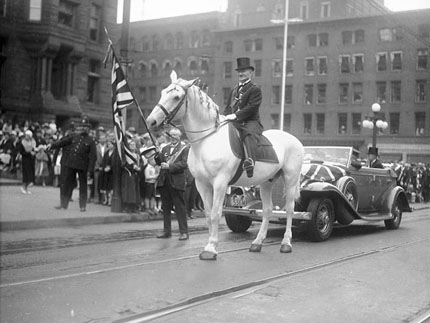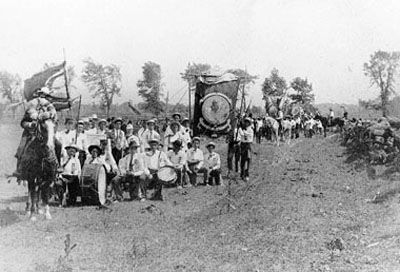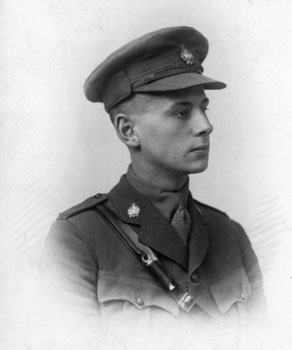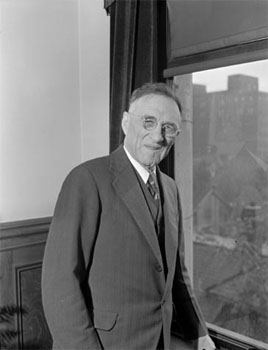Creation
The Orange Order was founded as a political and religious fraternal society in the Irish province of Ulster in 1795. It takes its name from the Prince of Orange, King William III, who reclaimed Britain’s Protestant monarchy when his forces defeated those of the Catholic King James II at the Battle of the Boyne, 12 July 1690. The Order emerged in Ulster as a product of the rivalry between Catholic-Irish and Protestant-British ethnic groups. Its principles included allegiance to the British monarchy, Protestantism and conservative values such as respect for the laws and traditions of Great Britain.
Membership and Expansion
Irish-born Protestant immigrants and soldiers transplanted the Orange Order to the shores of British North America in the early 19th century. While dominated by Irish Protestants, the Orange Order in Canada quickly accepted English, Scottish, German and First Nations members, as well as some United Empire Loyalists. Although Protestantism was necessary for membership, not all denominations tended to join. In Canada, Methodists and Anglicans outnumbered the more evangelical Baptists and Presbyterians. While precise figures are difficult to verify for the 19th century, numbers increased swiftly from about 14,000 in 1834 to around 60,000 in 1900. The Order was strongest in Ontario, New Brunswick and Newfoundland, yet it spread to every province and included members of all ages from all social backgrounds and classes. This wide membership generally reflected the demographic configuration of the area in which a lodge was found, including mining and logging towns, Prairie communities and urban centres. Lodge size varied greatly; however, the average lodge had 25–40 members in rural areas and double that figure in urban areas. At the peak of the Order in 1920, there were about 100,000 members in 2,000 lodges throughout Canada and the British colony of Newfoundland. In this latter region, about one in three adult Protestant males was a member of the Order, making Orangeism more popular there than anywhere else in the world, including Northern Ireland.
Key Principles and Functions
An important and multifunctional institution in Canada, the Orange Order provided significant mutual aid. Financial support was provided to members during times of illness or unemployment, and, upon a member’s death, the Order often alleviated the financial burden on widows and orphans by covering funeral costs and defraying burial fees. Lodges were sites of social activity, providing members with the chance to catch up on gossip, share a meal and build networks, all of which was especially important in rural areas that had little in the way of established institutions. Through such activities, the Orange Order and its lodges helped to cultivate a sense of community for settlers and farmers as well as for urban dwellers. Fraternal association was reinforced through the rituals, ceremonies, initiations, passwords and famous Orange sashes worn in council sessions and parades.
Like their fellow members around the world, Orangemen in Canada were devout Protestants and steadfast adherents to the British crown and its colonial representatives. Such allegiances were especially visible in parades, when members chanted and carried banners that showed their support for God and country. Canadian Orangemen shared a conviction that the nation’s destiny was tied to imperial ambitions. They fiercely supported Upper Canada’s colonial government during the 1837 Rebellion, and, after Confederation, they eagerly championed Britain’s entry into military engagements such as the Boer War and the First World War.
Controversies and Tensions
The relationship between Orangemen, the monarchy and its representatives was fraught with tensions. Colonial administrators in Upper Canada/ Canada West were at times thankful for their loyalty and service, and other times disparaged their penchant for violence and secrecy. The colonial assembly made some efforts to have the Order abolished in the 1820s and 1830s and even outlawed Orange parades between 1843 and 1851. Perhaps most famously, the Prince of Wales and his political advisor, the Duke of Newcastle, shunned the Orange Order during the Royal Tour of 1860. They refused to participate in any Orange displays of fidelity while they openly met with Catholic leaders in Canada East. Around 150,000 frustrated Canadian members signed a petition noting that the Prince was too tolerant toward Catholics. The Order’s Grand Master of British North America, John Hillyard Cameron, delivered the petition to Queen Victoria, who promptly disregarded it.
Anti-Catholicism
From their early 19th-century arrival to the 1950s, the Orange Order in Canada developed a reputation for sectarianism and regularly resisted any perceived Catholic interference in civic affairs. Its members generally viewed Roman Catholics and French Canadians as politically disloyal or culturally inferior. Some Orange members argued that their association was the only one capable of resisting Catholics who, they believed, were subservient to the Pope’s spiritual and political authority and who were therefore disreputable crown subjects. Orangemen favoured government forces’ intervention in the Red River Rebellion of 1870. Following the execution of Orangeman Thomas Scott, they supported John A. Macdonald and his government’s decision to send troops to put down the Métis leader Louis Riel in the North-West Rebellion of 1885. Orangemen disparaged the Jesuits’ Estates Act of 1888 and resented the influx of French Canadian Catholics into Eastern Ontario at the turn of the 20th century. Finally, in the debates surrounding the Manitoba Schools Question and the Ontario Schools Question, Orangemen vigorously agitated against Catholic education because of its ties to the French language.
Suspicion of Catholic citizens was sometimes manifested in violent clashes. Although usually short and rarely leading to death, riots between Orange and Green factions occurred regularly and in a wide variety of settings, including political meetings, election polling stations, Catholic and Protestant parades, and during visits from contentious spiritual and secular leaders. The most well-known riots involving the Orange Order took place in Saint John, New Brunswick in 1847 and 1849, in Toronto in 1875 and in Harbour Grace, Newfoundland in 1883.
Political Influence
Ogle R. Gowan founded the first Grand Lodge of British North America on 1 January 1830 in Brockville, Upper Canada. Elected as Grand Master, Gowan sought to use this position as a base for a political career, which he achieved with mixed results over the following three decades. Nevertheless, he set in motion a close relationship between political office and Orange Order membership. Indeed, no fewer than four Prime Ministers —including Sir John A. Macdonald — and at least 10 premiers belonged to the Order, as did countless mayors from coast to coast. From the mid-19th until the mid-20th century, members exerted significant political influence, particularly at the municipal level. In Toronto, for example, almost every mayor of the city was an Orangeman between 1850 and 1950. The power of patronage was evident: scores of Orange-friendly administrators, aldermen, police, firemen and public works employees were appointed, and members were pressured to vote for Orange officials. In fact, during the late 19th century, Toronto was sometimes referred to as the “Belfast of Canada,” a designation referring to its sectarianism and the Orange influence in municipal governance.
Transformation and Decline
Despite occasional flares of sectarian violence, the Order had become more reputable by the early 20th century. Alongside the traditional tenets of loyalty to empire and Protestantism, Orangemen also promoted temperance, morality and self-improvement and regularly hosted respectable leisure activities such as sporting and music events. Organized in December 1888 and incorporated 12 June 1895, the Ladies' Orange Benevolent Association assisted Orangemen in these endeavors while also providing insurance benefits to their own members. Since the 1960s, several factors have contributed to a waning membership: the reality of — and members’ failure to adapt to — the growth of Canadian nationalism, a decline in the British connection, the rise of the welfare state and declining need for fraternal societies, ethnic diversity, secularization and alternative means to spend one’s free time. While the Orange Order today is multicultural, its membership has declined considerably, standing at around 5,000–6,000 people scattered throughout a few hundred lodges across the country.
See also Toronto Feature: Orange Order.

 Share on Facebook
Share on Facebook Share on X
Share on X Share by Email
Share by Email Share on Google Classroom
Share on Google Classroom













